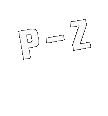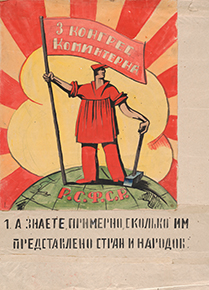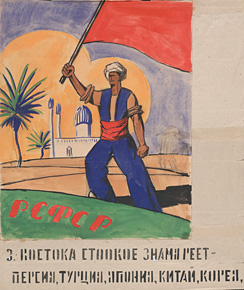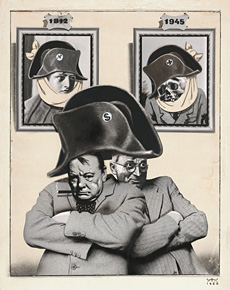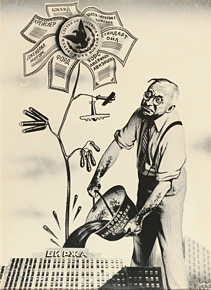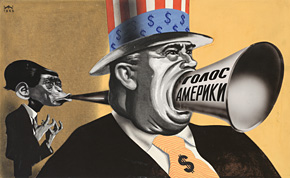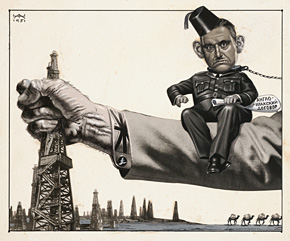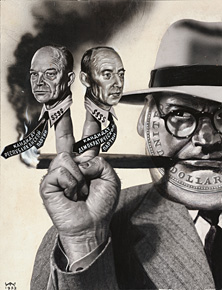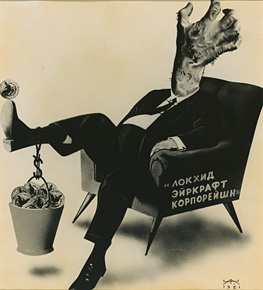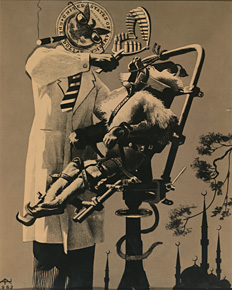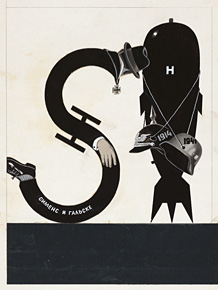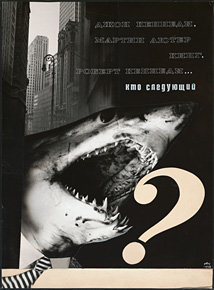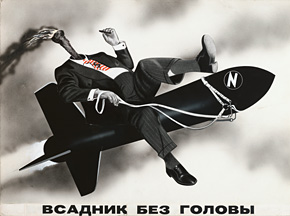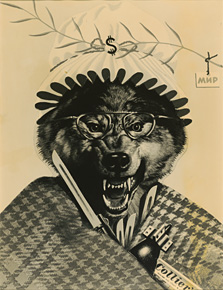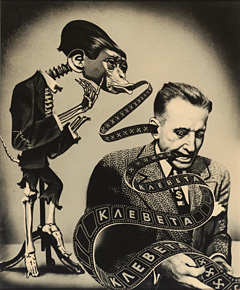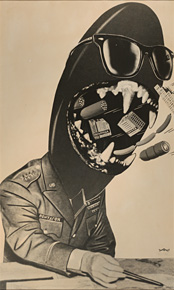

Antonín Pelc | Natalja Pinus | T. Povzněr | ROSTA windows | N. Š. | Wolfgang Schlosser | Sergei Senkin | T. Šišmareva | Bohumil Štěpán | Iraklii Toidze | V. Vlasov | Vstrachov | ALEXANDER ZHITOMIRSKY
In the captions artists' titles are in italics, descriptive titles are in roman, and inscriptions taken from the artwork are in quotation marks.
Dimensions are in inches.
ROSTA windows
The ROSTA Window posters were published in the early days of the Russian Revolution by the Russian Telegraph Agency (Rossiiskoe Telegrafnoe Aganstvo, or ROSTA). Produced between 1919 and 1921, these posters were created to pass on news and instill state-supported values, running the gamut from the mundane (publicizing the compulsory smallpox vaccination) to the heroic (donating food, clothing, and shelter to the Red Army). In order to communicate with the semi-literate population, the ROSTA artists developed an iconographic lexicon that related blacksmiths with industriousness, sunshine with prosperity, and cobwebs with idleness.
The images were stenciled on to paper or plywood by groups of artists and then hung in shop windows, as well as railroad stations and marketplaces for maximum exposure. They were sequenced like a comic strip, often numbering anywhere between four and twelve panels in a thematic series. At a time when machinery was in disrepair and paper in short supply, the ROSTA Windows provided an easy way for the State to communicate with a pre- or semi-literate population.
The first ROSTA Window appeared in Moscow. The original concept was developed by artist Mikhail Cheremnykh in collaboration with journalist N. K. Ivanov. Cheremnykh (Russian, 1890-1962) studied at Moscow’s School of Painting, Sculpture, and Architecture and served as the director of the ROSTA Art Department from the project’s inception to its demise in 1921. Vladimir Mayakovsky (Russian, 1893-1930), a Revolutionary/Futurist poet, joined the Moscow ROSTA commune shortly after seeing the first poster published. Although he had no official title, he was often recognized as the director of the entire ROSTA project. He was responsible for writing the majority of the texts and composing roughly a third of the images.
By 1921, over fifty ROSTA offices had been established outside Moscow in cities such as Petrograd and Odessa. Information was telegraphed from the central ROSTA agency to outlying groups, where teams would write the text and compose the images. In all, roughly 1,600 original series were created and two million frames were duplicated.

ARTIST UNKNOWN
ROSTA Window series #160
c.1920
Hand-cut stencils with watercolor pigment, approx. 22¼ x 17

ARTIST UNKNOWN
Original watercolors for ROSTA Window series #188
c.1920
Watercolor pigment and india ink, approx. 22¼ x 17

VLADIMIR MAYAKOVSKY
Russian, 1893-1930
ROSTA Window series #42
February 1921
Sowing Campaign: Let's fulfill the decree!
Hand-cut stencils with watercolor pigment
15¾ x 16¼ to 17 x 16¾ each

VLADIMIR MAYAKOVSKY and MIKHAIL CHEREMNYKH
Russian: 1893-1930 and 1890-1962, respectively
ROSTA Window series #81
March 1921
All for Farming Equipment Repair Week!
Hand-cut stencils with watercolor pigment
20½ x 13½ to 21¼ x 14¼ each

WOLFGANG SCHLOSSER
Czech, 1913-1984
"Firm Foundation: Fy Adenauer, formerly Adolf Hitler & Co."
1953
Lithograph
23¼ x 16½

BOHUMIL ŠTĚPÁN
Czech, 1913-1985
"Yesterday a collaborator/Today an alarmist"
c. 1945
Lithograph
49¼ x 36¼

IRAKLII TOIDZE
Russian, 1902-1985
"Under the banner of Lenin, with the leadership of Stalin, forward to the victory of Communism"
1940
Lithograph
47¼ x 33
ALEXANDER ZHITOMIRSKY
Alexander Zhitomirsky's political photomontages are a significant and little-recognized moment in the history of photography, adding to a genre that has few exponents beyond the seminal John Heartfield. His chillingly caustic images tell the tale of capitalist enemies driven by imperialistic warmongering, sinister deals, and moneyed big business. In the immediate postwar period, he posited American capitalism as the new Nazism with the United States, anthropomorphized in the figure of Harry Truman, marching to the beat of a Nazi drum. During the Cold War, Zhitomirsky employed the imagery of the surreal to evoke a world of false facades and hidden conspiracies, where the wolf of capitalism lurks behind a friendly mask and disembodied hands indicate the presence of capitalist enemies both evil and depraved.
Zhitomirsky was born in 1907 in Rostov-on-Don and moved to Moscow in 1925. He began as a publisher for the Artists’ Association of Revolutionary Russia and editor/typographer for journals such as We're Building, Socialist Industry, and Illustrated Newspaper. During WWII, Zhitomirsky produced some of his best known political photomontage. He worked on The Photo Newspaper for the Red Army, which told tales of Russian heroes, as well as the Front Illustrierte, which was dropped on enemy troops. Published in many languages — German, Italian, Finnish, Romanian, and Hungarian — these leaflets were intended to demoralize enemy soldiers. The Third Reich not only forbade German soldiers to collect the leaflets, but also added Zhitomirsky to its "most wanted" enemy list. He continued to produce works of political photomontage throughout the Cold War and died in 1993.

ALEXANDER ZHITOMIRSKY
Russian, 1907-1993
"John Kennedy, Martin Luther King, Robert Kennedy...Who will be the next one?"
1968
Photomontage (original photo)
20½ x 15¼




















